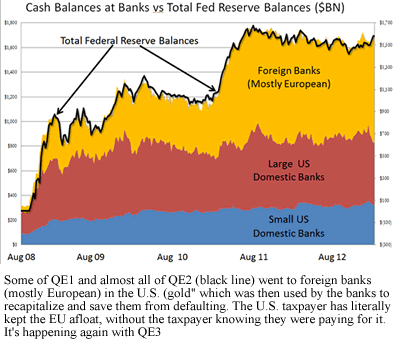THE GLOBAL FINANCIAL
DEATH SPIRAL?
PART 1
By
Kristie Pelletier and Michael S. Coffman, Ph.D
August 27, 2013
NewsWithViews.com
Part I—The Disintegration of the Global Financial Architecture
Beginning in 2009, Estonia…implemented real austerity through actual spending cuts and tax reform that did not aim to increase revenue in nominal terms from its pre-austerity level… This was not the result of an increased average tax burden, which had fallen by approximately 6 percent from the previous year…, but it was the result of economic growth, which had already reached 2.3 percent in 2010 and 7.6 percent in 2011. The problem with the U.K.—and the rest of Western Europe—is that government is squeezing more and more tax revenue out of a shrinking economy. Matthew Melchiorre, Competitive Enterprise Institute, May 7, 2013
Most American’s have been so focused on trying to make ends meet as the purchasing power of their paycheck rapidly declines that they have only been peripherally aware of what is happening in the world at large. They occasionally hear about the upheavals in Europe and that China is undertaking currency manipulations, but nothing that would really alarm them. They never hear that Japan is in meltdown. Nor do they know that the American taxpayer is paying trillions to keep Europe afloat, even though there are in-your-face examples of what to do to get out of the financial death spiral they are in. The American people are being kept ignorant to keep them from understanding that global events are increasingly threatening everything we take for granted – in a potentially devastating way.
Japan has taken the spending practices of the West and kicked it up to a whole new level. As of this year, they owe 250% of GDP in debt. Just like the U.S., they are trying to print their way out of trouble by firing up the currency printing presses. Over the past year, the value of the Yen has fallen almost 20%. All of this has caused the largest credit bubble in Japan’s history. All of this uncertainty and instability in Japan is causing a crisis in other countries of the region. Japan’s bond market is literally in meltdown threatening their solvency, while China is using smoke and mirrors to convince the world it is wildly prospering.
Fed up with what it sees as Washington's debauching of the dollar, China is busily promoting the use of its own yuan as the reserve currency with nine other nations. GoldSilver.com writes: “Displacing the dollar, Beijing says, will reduce volatility in oil and commodity prices and belatedly erode the ‘exorbitant privilege' the United States enjoys as the issuer of the reserve currency at the heart of a post-war international financial architecture it now sees as hopelessly outmoded.” No mention is made that if China is successful, it will make the U.S. dollar worthless.No mention is made that China has major debt problems of its own, as will be discussed in Part II of this Financial Death Spiral series.
Some of QE1 and almost all of QE2 (black line) went to foreign banks (mostly European) in the U.S. (gold) which was then used by the banks to re capitalize and save them from defaulting. The U.S. taxpayer has literally kept the EU afloat, without the taxpayer knowing they were paying for it. It’s happening again with QE3.
Europe
is still in deep trouble and continues to get worse, in spite of the
$630 billion U.S. dollar bail out by the Federal Reserve (Fed) in QE2
(Quantitative Easing, round 2). This was secretly
doled out to European banks, in an  enormous
bailout of the various failing economies of the Eurozone. Indeed, many
major economies around the world are still floundering. Besides the
nations of the European Union, Japan, China, Brazil and many other nations
are in trouble or are on the verge of collapse.
enormous
bailout of the various failing economies of the Eurozone. Indeed, many
major economies around the world are still floundering. Besides the
nations of the European Union, Japan, China, Brazil and many other nations
are in trouble or are on the verge of collapse.
In the early weeks of the summer of 2013, with hints of the Fed’s
belt tightening called “tapering,” investors pulled over
$40 Billion dollars from emerging
bond markets like those of Brazil, Russia, India and China leaving
them short of cash to run their respective governments. In efforts to
stay afloat many of these nations are turning to state capitalism, where
the state slows reforms needed to encourage private enterprise, while
it simultaneously takes more control of production, capital, national
resources and other income producing ventures, from private enterprise.
This, of course, will only speed up their downfall as they make it harder
and harder for individuals and private businesses to prosper in the
historically misguided belief that government knows what’s best.
The worldwide business outlook and optimism is the worst since the 2008 crisis. Much of the lack of confidence is being generated by the dire situations in the U.S. and China; and to a lesser degree in Europe and Japan. The civil unrest that occurs in the wake of economic uncertainty only increases the likelihood that investors will continue to remain cautious and pull back even more – further damaging the economies of these nations.
The big bailouts that happened in the U.S.and abroad will only serve to delay a broad global collapse. Central banks bought up debts of nations that are so far under water, ours included, that those countries will never be able to come good on those debts. Nation after nation is completely upside down in their debt/income ratio, with no end to government spending in sight. Furthermore, those same central banks, including the Fed, have then turned around and printed trillions in paper currency out of thin air, greatly devaluing it in various countries. Stansberry Research, a group having an astounding record of predicting major financial events around the world and in the U.S., reported that we are continually digging the hole deeper and deeper:
The government spending in excess of tax revenue – is being directed toward nonproductive uses by politicians seeking greater power and authority. It doesn't reflect the markets responding to a legitimate economic demand. So it's impossible for it to increase the productivity or the wealth of any country. This is the central lesson of the 20th century: Massive government spending does not lead to prosperity. It leads to war.
Stansberry also warns: “We've seen unbelievably risky moves in the market. They foreshadow a massive change in the economic structure of the world.” “In other words,” notes Stansberry, “markets are starting to wonder how we're going to unwind the massive fiscal stimulus that has boosted markets for the past five years.” The rein lies the looming financial death spiral.
Europe
The situation in Europe has led many finance experts to speculate that the European Union (EU) is nearly at a “stay-united-or-dissolve” crisis point. It doesn’t really work for nations that “appear” stable and thriving economically like Germany and the Netherlands to be bound with nations that are going under. The problems in Europe are a matter of public record in countries like Spain, Ireland, Portugal, Cyprus, and Greece (PIIGS).
Italy’s sovereign debt is seven times that of Greece and is technically bankrupt. Italy’s sovereign debt is projected to pass 130 percent in 2013. The only thing keeping it afloat is money printed out of thin air by the Fed and EU central banks. If Italy, Spain, Portugal or any other major economy in the EU goes down, staying successfully united will not be possible.
Things seemed to be getting much better in January, 2013 when 278 European banks repaid a greater than expected €137.16 billion of the €1 plus trillion in the second Long Term Refinancing Operation (LTRO). The bailouts were disbursed to the banks in early 2012 to save them from default. The repayment was made with much pomp and circumstance and was accompanied by much relief. The price of the Euro shot up on the news. However, many analysts were not so sure, believing it to be a sham. To them every indication showed the banks were still in very big trouble.
It turns out the skeptics were right. By February when the European banks were slated to make another installment to LTRO in the amount of 122.5 billion euros, they were unable to come up with even half of it. The result was an immediate slip in the Euro. Greece is failing to meet the austerity demanded by the European Central Bank (ECB), IMF and the EU Commission and is unlikely to get a second LTRO bailout. That would mean it finally declares bankruptcy after years of being technically bankrupt but artificially kept afloat with cash infusions by the EU and IMF. Neither Spain nor Italy is much better, with Spain having 27 percent unemployment.
Following the failure of the European banks to meet the expected LTROs payment in February, some things got slightly better. Amongst back-slapping and congratulations, Sovereign debt (debt of nations, not banks) improved slightly and the European stock market reached near record highs by July. However, as ZeroHedge.com noted that: “record unemployment rates, record loan delinquencies, record drops in house prices, and record deposit outflows can all be ignored” because president ECB Mario Draghi, said no matter what, he “will do whatever it takes” to bail them out. (Bold original) This, of course, means printing more funny money out of thin air.
Despite Draghi’s exuberance, Europe remains in big trouble as reality takes its toll. Bank funding is becoming increasingly volatile and the trend shows no sign of abating. JP Morgan warns that the excess cash in the Euro area banking system continues to decline, down to €230 billion. Rather than paying down the LTROs, the banks are soon going to need the third LTRO cash infusion. True to his word, Draghi announced the first of August that he would hold the “door open for another interest rate cut if the euro area economy needs more stimulus.” At the time, the ECB interest rate was at 0.5 percent. As usual, Draghi claimed, with no evidence, the 17 nation Eurozone has stabilized and will start to grow slowly out of its recession.
The machinations and empty promises the EU is using to keep the union together are considered by some to be purely socialistic in nature and will only bring disservice to the people of Europe. The same is true for the United States (U.S.) which will be discussed in Parts III through V in the Financial Death Spiral series. Tragically, the socialist, blood sucking bureaucratic programs of many nations of the Eurozone are very likely going to pull those nations under in the financial death spiral they are now in.
Nations hit a crisis level when they spend above 25% of GDP. France is spending 50% of GDP and other nations of the Union are spending upwards of 40%. Furthermore, these nations are also hemorrhaging deficits that exceed their stagnated growth rates. All of that is compounded by crippling taxes and regulatory strangleholds on private business. In most cases these socialist-based regulations, which exceed those of the U.S., will ensure their failure. The debt crisis in Europe has also caused a reduction in the use of Euros as reserve currency held globally by central banks.
Why Some European Nations Are Not Affected
The nations of Western Europe might want to take a lesson from the north and east. The Scandinavian countries of Norway and Denmark have historically had healthy economies and have suffered little during the double recession plaguing Europe. The nations of Sweden and Estonia have only recently implemented true austerity measures… real spending and tax cuts, not just double speak while taxing business even more.
The cut in key (not all) government taxation and spending have given Sweden and Estonia growth while most of Europe is stagnating or in decline as their highly socialistic/anti-business programs shackle their economies. The nations that have taken austerity seriously by reducing the size and scope of government while encouraging private enterprise have seen economic growth.
Most of the EU nations have implemented austerity measures against the private sector by raising taxes and imposing further regulations, while only making cosmetic cuts in government. Amazingly, when this results in further economic deterioration, the media blames it on shrinking the size of government, when in fact, it is due to the restrictions on private enterprise. This blindness is typical of the progressive socialist mind and will not end well for Europe.
While Sweden needs to go further, the strong steps they’ve taken so far have kept them out of the recession that is drowning most of the rest of Europe. Andreas Norlén, a Moderate Party member of the Swedish Parliament, said:
Sweden now has arguably one of the strongest economies of the 27 EU states. We project a very small deficit for 2013 (0.6 percent of GDP), along with a falling public debt (around 37 percent of GDP), and a growing economy. We will, of course, not remain unaffected if the crisis deepens in the Eurozone, given that 50 percent of our GDP consists of export revenue, but our sound fiscal situation does allow us to meet falling exports with limited stimulus.
Once one of Europe’s most socialist nations, Sweden experienced a severe economic crisis in the early 1990s that put them face to face with the reality that socialism doesn’t work. They immediately implemented 15 years of reform that reduced key taxes and social programs, while encouraging free market principles. They instituted a:
pension system that is autonomous from the budget, and which cannot have a deficit—if fees do not cover costs, pensions are automatically reduced. We reformed social security benefits and increased mechanisms to help people get back to work quickly. We cut income taxes, primarily for people with low or middle incomes, to create stronger incentives for work. We sold government-owned companies, abolished monopolies, and improved incentives for starting businesses and for investing. These policies continue. Next year, we will reduce the corporate tax rate from 26.3 to 22 percent.
Norlén concluded his talk saying: “The future economic stability of Europe depends on its willingness to make the kind of tough and broad reforms Sweden has made.” With the solution to Europe’s economic death spiral literally staring them right in the face, why can’t the leaders of Europe, indeed the U.S., see the Swedish model as their solution? They must abandon the Keynesian model that has caused such a disaster for them. They won’t because they can’t. Why?
The socialist ideology gripping Europe blinds them to reality. Although this will be discussed more in Part V of the Financial Death Spiral series, psychiatrists have been reporting for over 100 years that socialists (called progressives in the U.S.) cannot connect to reality and therefore cannot change their mind. As detailed in Dr. Michael Coffman’s book Plundered, How Progressive Ideology is Destroying America socialists/progressives “think with their emotions” rather than critically in the real world; so what they think is right is too often based on their own contrived false reality.
Like Sweden, Estonia is also outperforming its West European neighbors. Besides Sweden, Estonia is the only Euro Zone country to implement real spending cuts and tax reform that does not involve squeezing more revenue out of an economy in recession. Writing for the Competitive Enterprise Institute, Matthew Melchiorre observed:
Beginning in 2009, it has implemented real austerity through actual spending cuts and tax reform that did not aim to increase [tax] revenue in nominal terms from its pre-austerity level. (There were tax increases as well as cuts, but these were not central to Estonia’s austerity program.) The United Kingdom has consistently increased outlays and revenues relative to its pre-austerity level in every successive 12-month period since June 2010... Estonia has consistently decreased both. Although Estonian revenues do begin to increase in the third year after austerity’s implementation (2011), this was not the result of an increased average tax burden, which had fallen by approximately 6 percent from the previous year …, but it was the result of economic growth, which had already reached 2.3 percent in 2010 and 7.6 percent in 2011. The problem with the U.K.—and the rest of Western Europe—is that government is squeezing more and more tax revenue out of a shrinking economy.
Unfortunately, socialists can rarely bring themselves to reduce the size and scope of government; it is a pure anathema to them. They truly do believe that only big government can solve economic and social problems and create their vision of a utopian society.In an attempt to get the money and power they are convinced they need, lest their world end, they insist on forever over-taxing private business and the rich.
This includes continuing to implement hair-brained programs like their green alternative energy projects. Their green programs have failed almost catastrophically. Europe’s green energy effort, as is that of the U.S., is totally disconnected from reality. It always has been. Yet, most of the European nations continue to pay out vast subsidies to green industry in hopes of somehow forcing green energy to work, when it can't with current technology and cost. More on this in Part V of the Financial Death Spiral series. This socialist/progressive ideological blindness is why they have failed so miserably. As long as they can continue to print money out of thin air they will never be forced like Sweden and Estonia to face the reality of their disastrous failure.
| Subscribe to the NewsWithViews Daily News Alerts! |
Margaret Thatcher, former Prime Minister of England when Reagan was president, said “The problem with socialism is that eventually you run out of other people’s money [to spend].” Europe and now the U.S. has run out of other people’s money and they haven’t a clue as to what to do except what is in their psychological DNA: tax and spend some more. The only other reason we are in the mess we are in is if it is being done deliberately, which unfortunately, is a real possibility. More on that possibility in a future article.In any event, this will not end well for Europe or the world.
Europe’s failure should serve as a glaring warning for the U.S., but tragically the U.S. is also controlled by progressive ideology and is as blind as Europe. There is a saying from Proverbs 12:15 that Europe and the U.S. should heed: “The way of fools seems right to them, but the wise listen to advice.” Sweden, Estonia and a few other nations have shown the wisdom that can get Europe out of its financial death spiral.It will only come at great cost, but that cost is much better than complete economic collapse.
Click here for part -----> 1, 2,
Part
I—The Disintegration of the Global Financial Architecture
Part II—China, Currency Wars and the U.S. Dollar
Part III—Inflation or Hyperinflation?
Part IV—The Bond Market Crash
Part V—Keynesian Disaster or Austrian Solution?













 Share
This Article
Share
This Article





